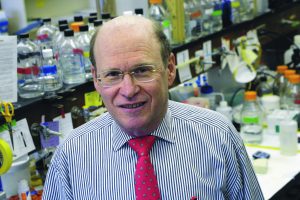
By McGill Reporter Staff
Researchers from McGill and the Université de Montréal have identified a crucial link between protein synthesis and autism spectrum disorders (ASD), which can bolster new therapeutic avenues.
Regulation of protein synthesis, also termed mRNA translation, is the process by which cells manufacture proteins. This mechanism is involved in all aspects of cell and organism function. A new study in mice has found that abnormally high synthesis of a group of neuronal proteins called neuroligins results in symptoms similar to those diagnosed in ASD.
The study also reveals that autism-like behaviors can be rectified in adult mice with compounds inhibiting protein synthesis, or with gene-therapy targeting neuroligins. Their results are published in the journal Nature.
ASDs encompass a wide array of neurodevelopmental diseases that affect three areas of behaviour: social interactions, communication and repetitive interests or behaviors. According to the U.S.-based Centers for Disease Control and Prevention, 1 in 88 children suffer from ASD, and the disorder is reported to occur in all racial, ethnic, and socioeconomic groups. ASDs are almost five times more common among boys (1 in 54) than among girls (1 in 252).
“My lab is dedicated to elucidating the role of dysregulated protein synthesis in cancer etiology. However, our team was surprised to discover that similar mechanisms may be implicated in the development of ASD,” explained Prof. Nahum Sonenberg, from the Dept. of Biochemistry, Faculty of Medicine, and the Goodman Cancer Research Centre. “We used a mouse model in which a key gene controlling initiation of protein synthesis was deleted. In these mice, production of neuroligins was increased. Neuroligins are important for the formation and regulation of connections known as synapses between neuronal cells in the brain and essential for the maintenance of the balance in the transmission of information from neuron to neuron.”
“Since the discovery of neuroligin mutations in individuals with ASD in 2003, the precise molecular mechanisms implicated remain unknown,” said Christos Gkogkas, a postdoctoral fellow at McGill and lead author. “Our work is the first to link translational control of neuroligins with altered synaptic function and autism-like behaviors in mice. The key is that we achieved reversal of ASD-like symptoms in adult mice. Firstly, we used compounds, which were previously developed for cancer treatment, to reduce protein synthesis. Secondly, we used non-replicating viruses as vehicles to put a break on exaggerated synthesis of neuroligins.”
Computer modeling played an important role in this research. “By using a new sophisticated computer algorithm that we specially developed to answer Dr. Sonenberg’s questions, we identified the unique structures of mRNAs of the neuroligins that could be responsible for their specific regulation,” explained Prof. François Major, of the University of Montreal’s Institute for Research in Immunology and Cancer and Department of Computer Science.
The researchers found that dysregulated synthesis of neuroligins augments synaptic activity, resulting in an imbalance between excitation and inhibition in single brain cells, opening up exciting new avenues for research that may unlock the secrets of autism.
“The autistic behaviours in mice were prevented by selectively reducing the synthesis of one type of neuroligin and reversing the changes in synaptic excitation in cells,” explained Prof. Jean-Claude Lacaille of the Groupe de Recherche sur le Système Nerveux Central and Department of Physiology at the Université de Montréal. “In short, we manipulated mechanisms in brain cells and observed how they influence the behaviour of the animal.”
The researchers were also able to reverse changes in inhibition and augment autistic behaviors by manipulating a second neuroligin. “The fact that the balance can be affected suggests that there could be a potential for pharmacological intervention by targeting these mechanisms,” Lacaille concluded.

both my son have asd my grandson 8 years old has been diagnosed as autistic since he was 3 as for my son who is 31 he was diagnosed as adhd.ocd developmentaly delayed ,however he functions and is able to comunicates ,my grandson however is mute very frustrating since we are not able to figure out what he needs could diet have an effect on reducing some of the autistic features ?